Abstract
Psychomotor skills and visual functions related to driving were measured double-blind cross-over in ten healthy volunteers before, and 1,3,5 and 7 h after a single oral administration of diazepam (10mg), medazepam (15 mg) or lorazepam (2.5 mg). The late effects of lorazepam were tested in seven other subjects 12 and 24 h after the administration. Lorazepam impaired almost all the measured skills more (P less than 0.05 to 0.001) than diazepam, medizepam or the placebo. The lorazepam impairment of reactive skills and flicker fusion discrimination remained statistically significant (P less than 0.05) for as long as 12 h. Medazepam impaired only reactive skills and flicker fusion, the latter remaining impaired (P less than 0.05) for as long a 5 h after the administration. The magnitude and duration of the effects of diazepam were intermediate between those of lorazepam and medazepam. Diazepam impaired perceptual speed and reactive and co-ordinative skills as well as flicker fusion discrimination and visual parameters related to driving. Slight impairments in performance were measurable for up to 5 h after administration but at 7 h the results resembled those measured after the placebo. The lack of alterations in adaptation to darkness, sensitivity to brightness or visual discrimination ability in bright counterlight at a time when flicker fusion discrimination was severely depressed suggests that an impaired ability to discriminate flickering light is of no or little clinical significance to driving ability. It is concluded that patients receiving a 2.5 mg dose of lorazepam should not drive or operate machinery for 24 h after the administration. After diazepam (10 mg) or medazepam (15 mg) patients should refrain from driving or participating inskilled performances for only 5 to 7 hours.
Full text
PDF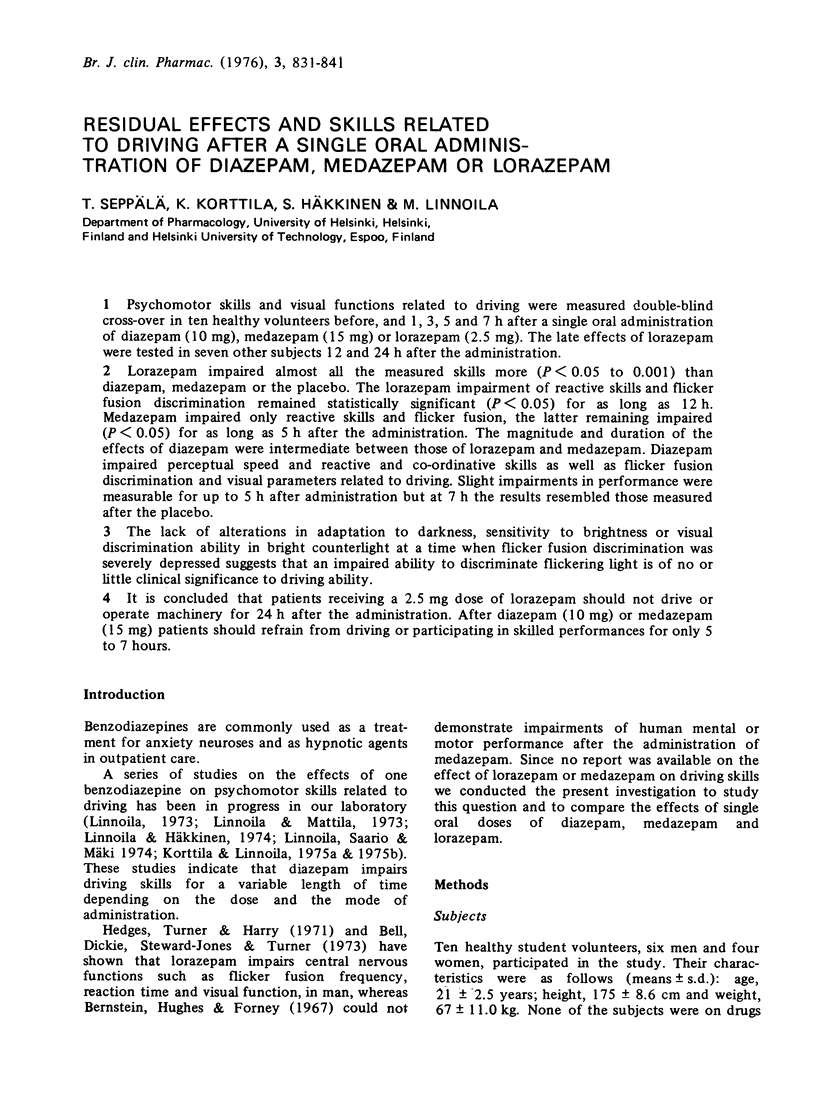
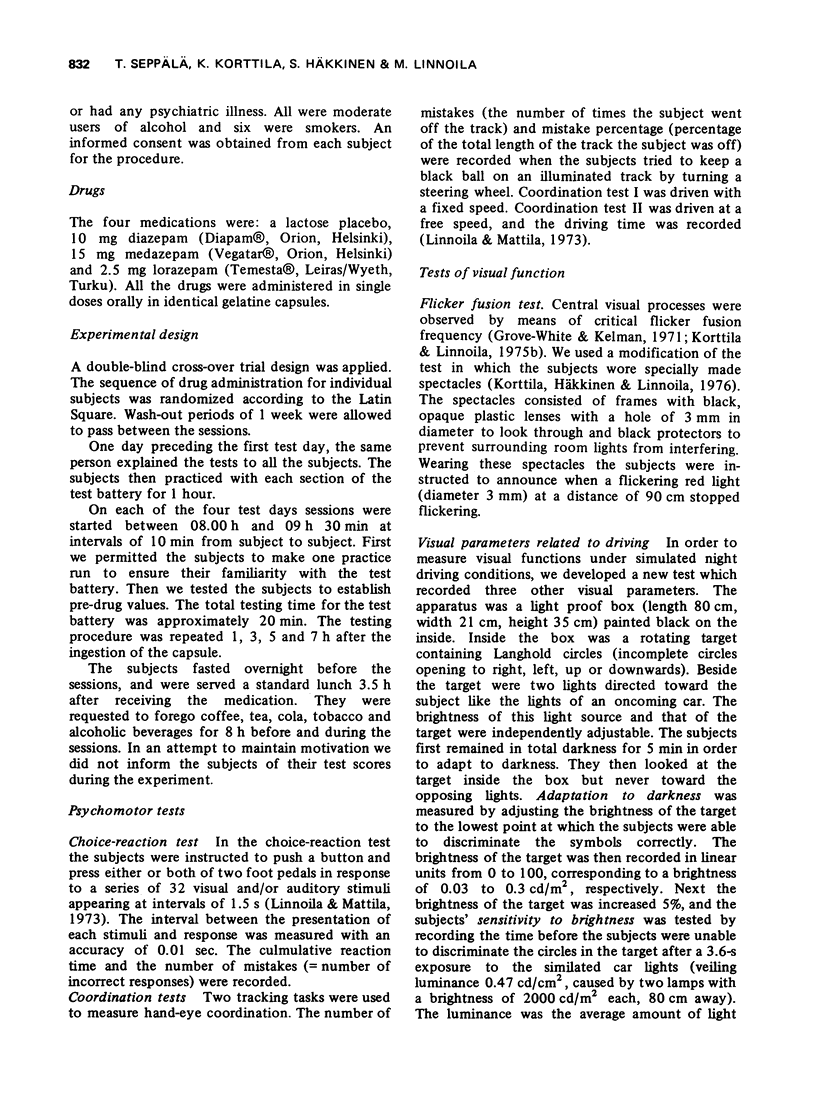
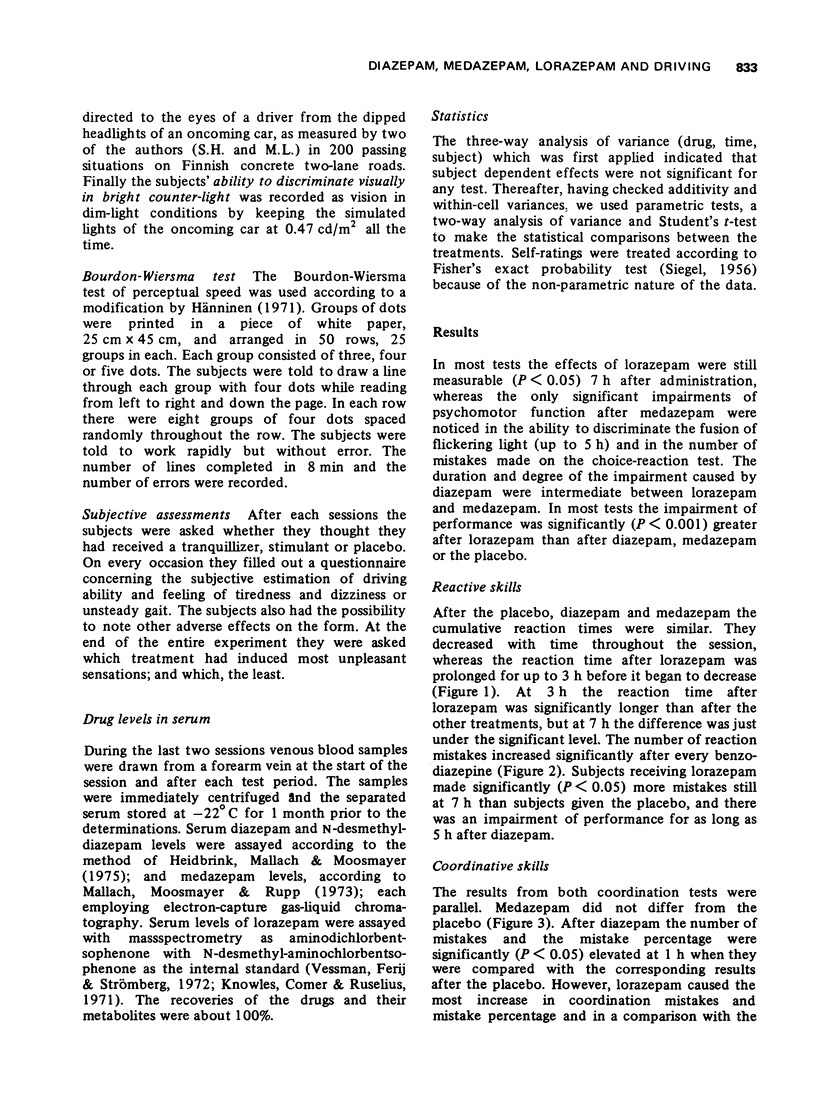
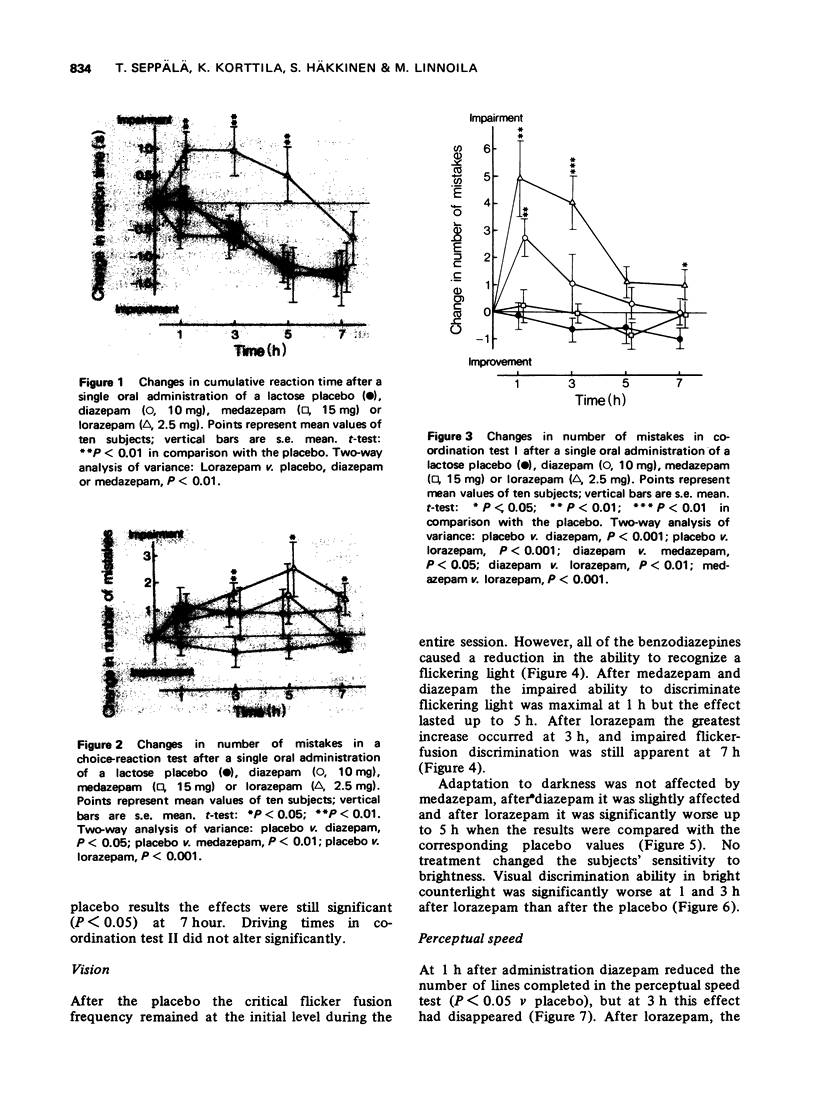
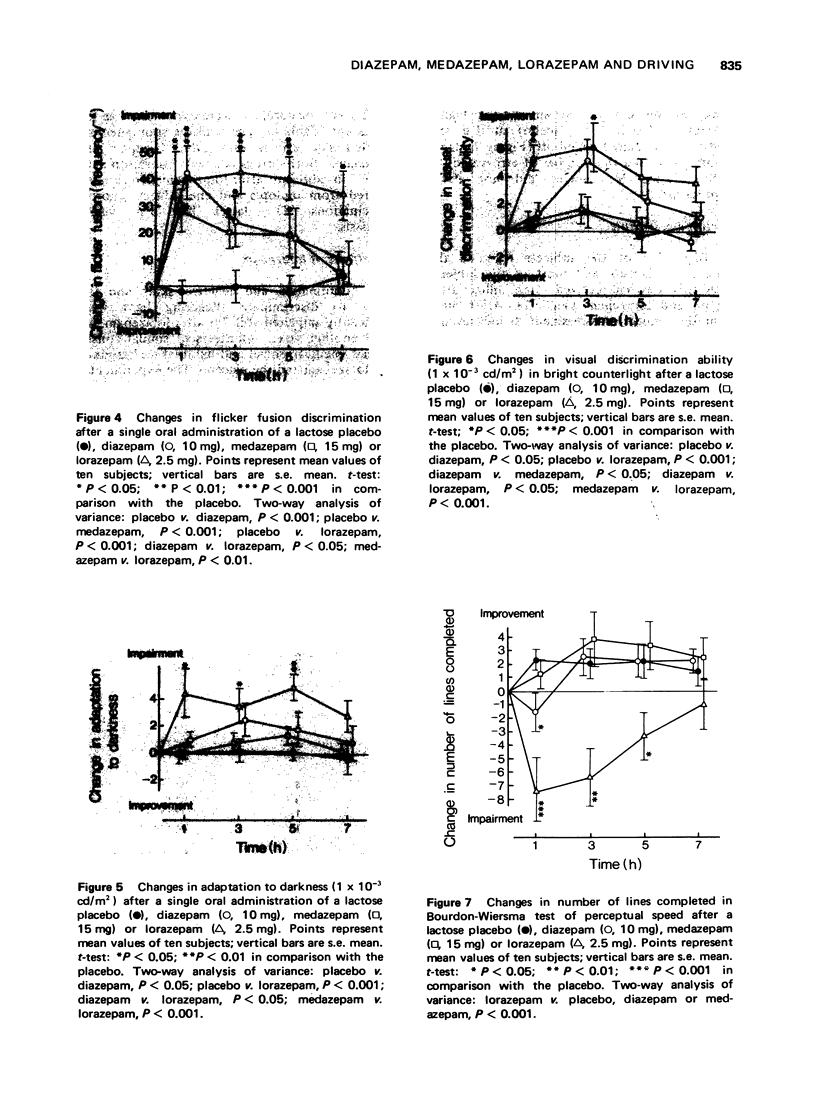
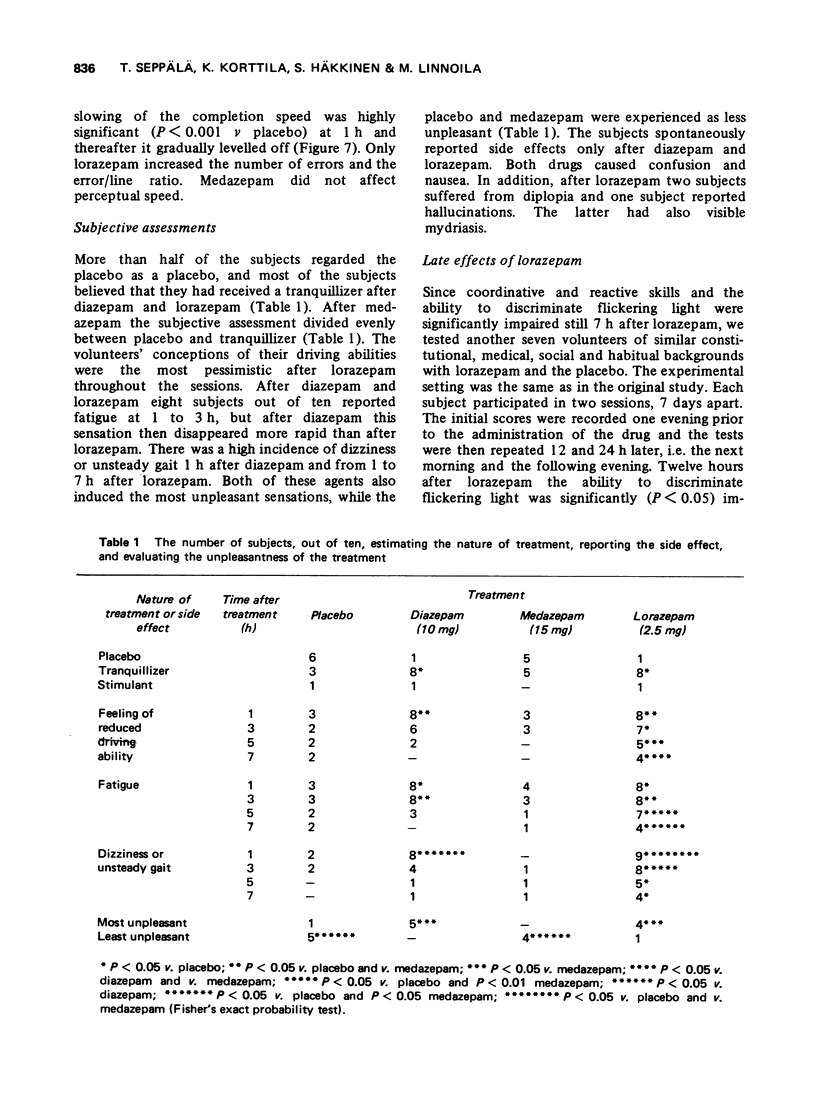
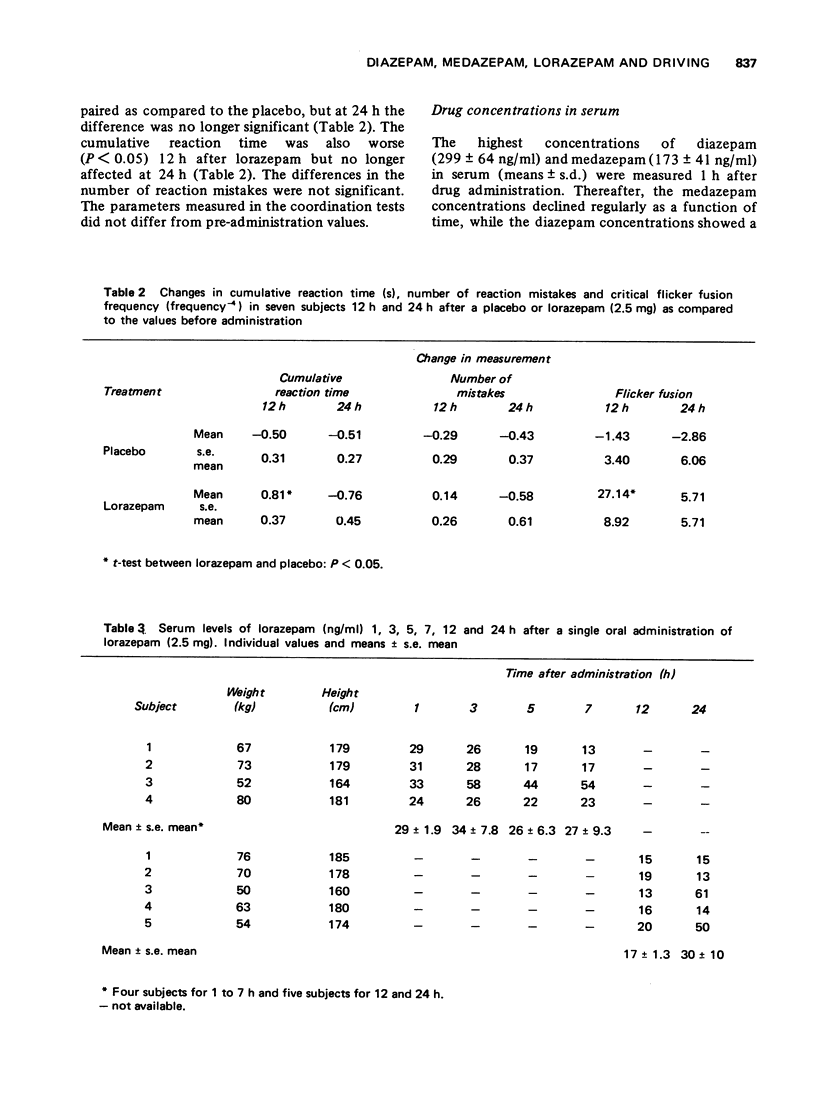
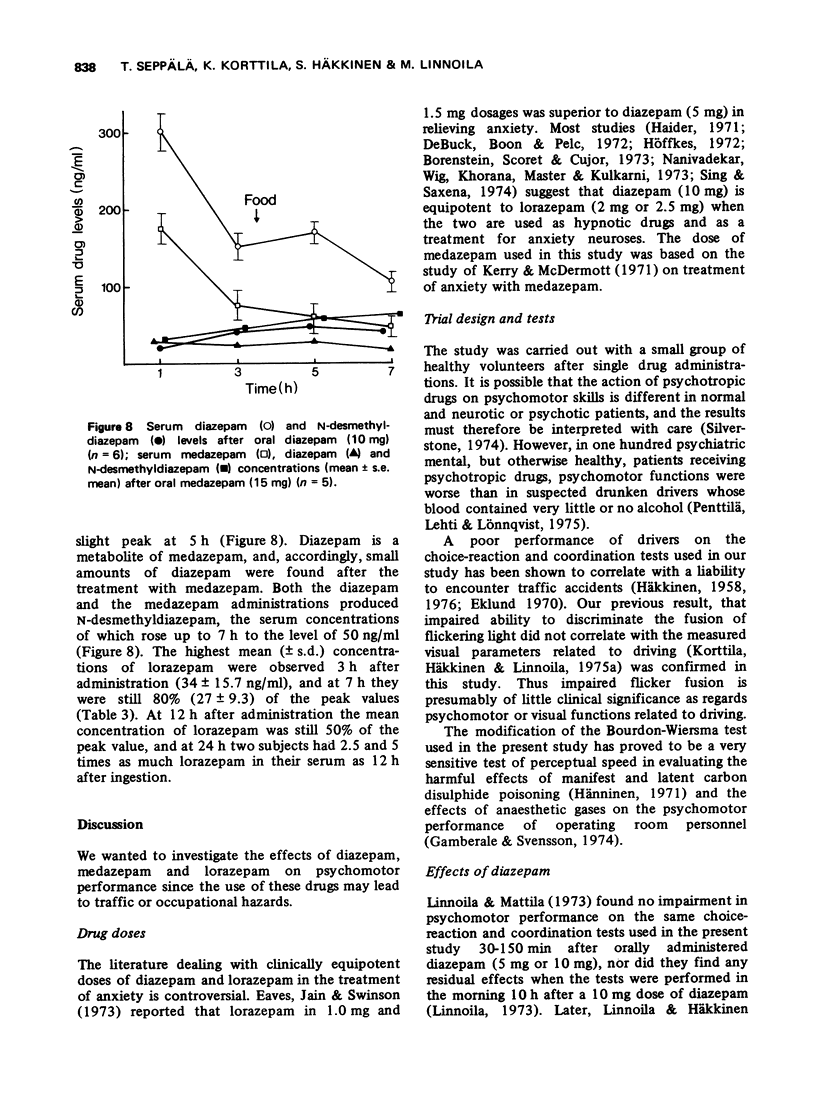
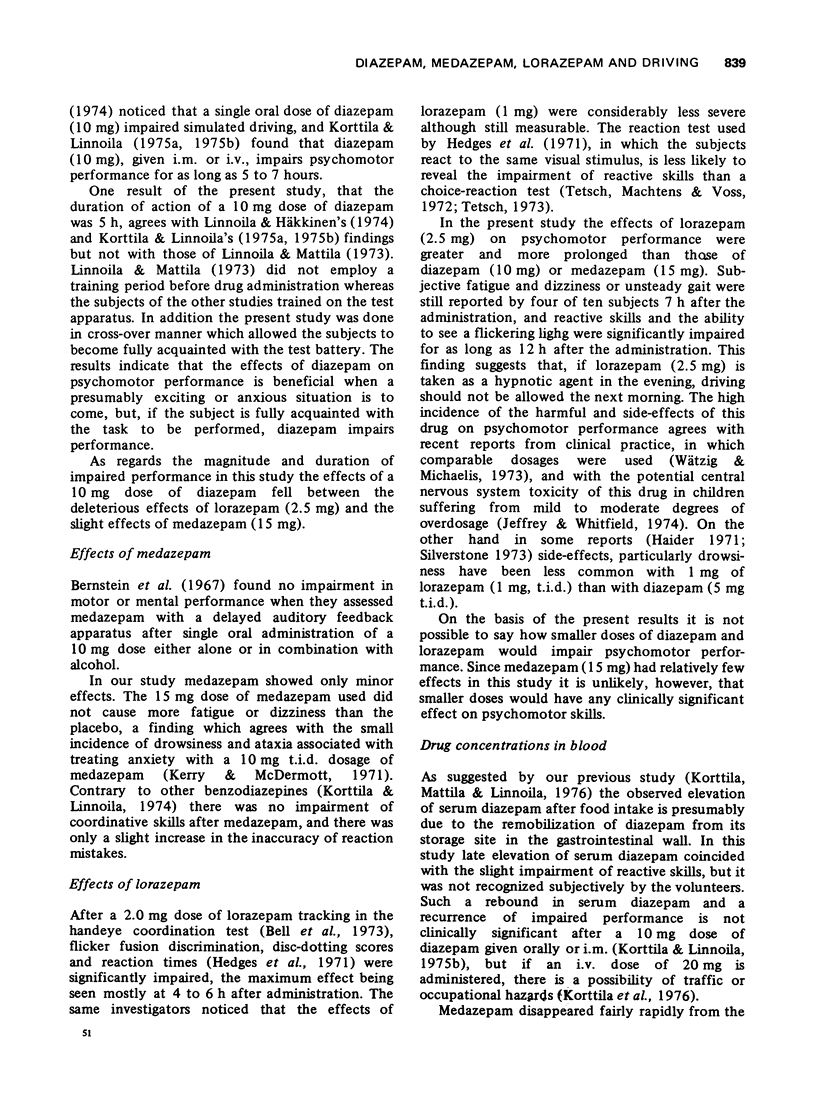
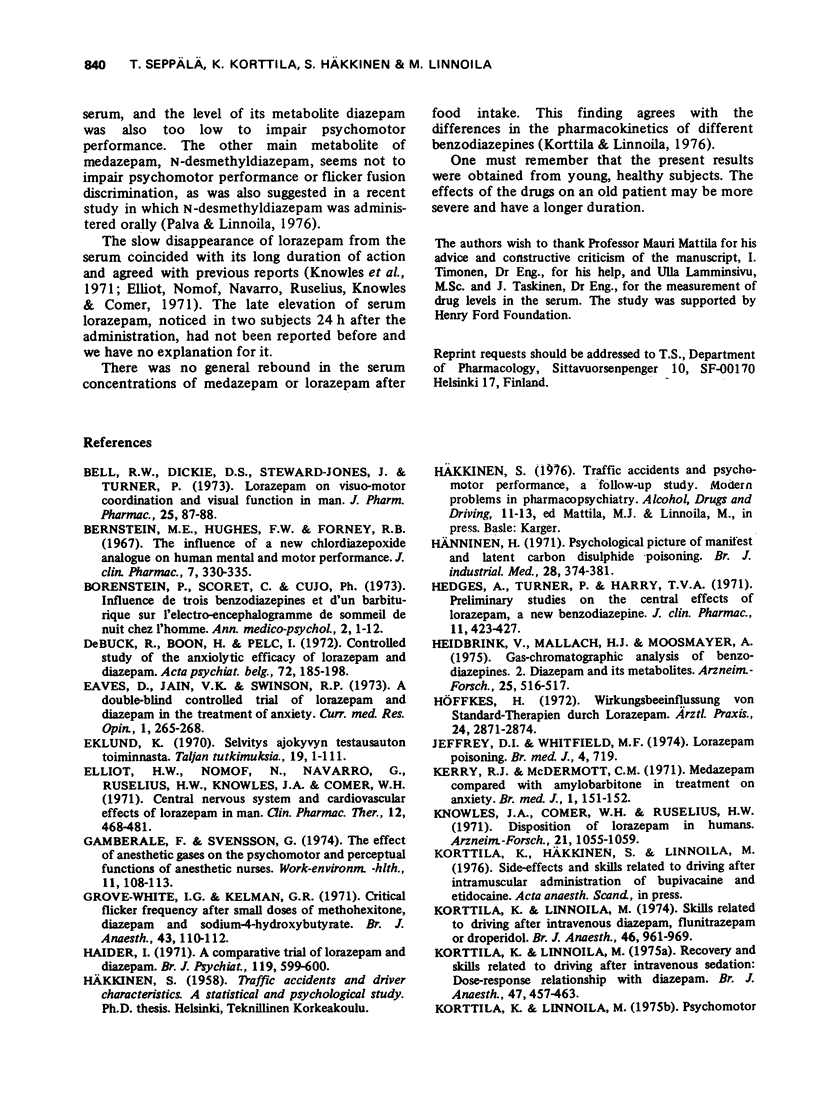
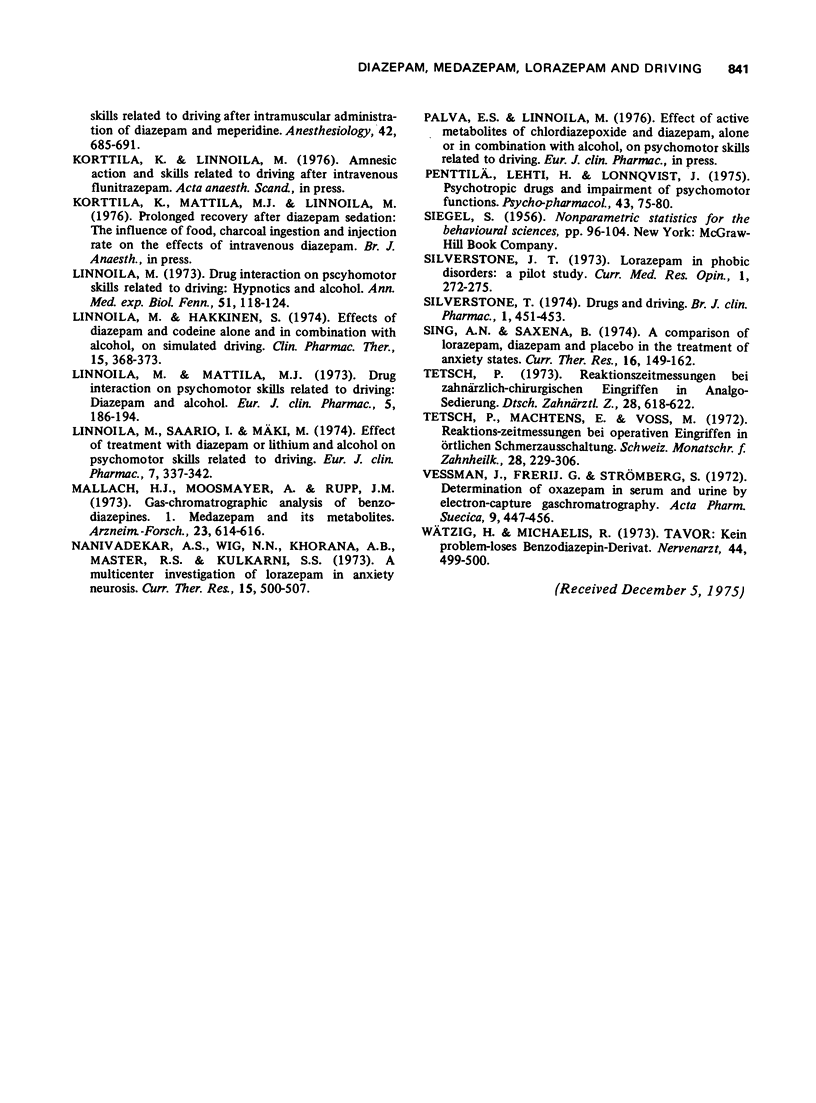
Selected References
These references are in PubMed. This may not be the complete list of references from this article.
- Bell R. W., Dickie D. S., Stewart-Jones J., Turner P. Lorazepam on visuo-motor co-ordination and visual function in man. J Pharm Pharmacol. 1973 Jan;25(1):87–88. doi: 10.1111/j.2042-7158.1973.tb09126.x. [DOI] [PubMed] [Google Scholar]
- Bernstein M. E., Hughes F. W., Forney R. B. The influence of a new chlordiazepoxide analogue on human mental and motor performance. J Clin Pharmacol J New Drugs. 1967 Nov-Dec;7(6):330–335. doi: 10.1002/j.1552-4604.1967.tb00075.x. [DOI] [PubMed] [Google Scholar]
- Borenstein P., Soret C., Cujo P. Influence de trois benzodiazépines et d'un barbiturique sur l'électro-encéphalogramme de sommeil de nuit chez l'homme. Ann Med Psychol (Paris) 1973 Jun;2(1):1–12. [PubMed] [Google Scholar]
- De Buck R., Boon H., Pelc I. Etude comparative contrôlée de l'effet anxiolytique du lorazepam (WY 4036) et du diazepam (Valium. Acta Psychiatr Belg. 1972 Mar;72(2):185–198. [PubMed] [Google Scholar]
- Eaves D., Jain V. K., Swinson R. P. A double-blind controlled trial of lorazepam and diazepam in the treatment of anxiety. Curr Med Res Opin. 1973;1(5):265–268. doi: 10.1185/03007997309111676. [DOI] [PubMed] [Google Scholar]
- Elliott H. W., Nomof N., Navarro G., Ruelius H. W., Knowles J. A., Comer W. H. Central nervous system and cardiovascular effects of lorazepam in man. Clin Pharmacol Ther. 1971 May-Jun;12(3):468–481. doi: 10.1002/cpt1971123468. [DOI] [PubMed] [Google Scholar]
- Gamberale F., Svensson G. The effect of anesthetic gases on the psychomotor and perceptual functions of anesthetic nurses. Work Environ Health. 1974;11(2):108–113. [PubMed] [Google Scholar]
- Grove-White I. G., Kelman G. R. Critical flicker frequency after small doses of methohexitone, diazepam and sodium 4-hydroxybutyrate. Br J Anaesth. 1971 Feb;43(2):110–112. doi: 10.1093/bja/43.2.110. [DOI] [PubMed] [Google Scholar]
- Haider I. A comparative trial of lorazepam and diazepam. Br J Psychiatry. 1971 Dec;119(553):599–600. doi: 10.1192/bjp.119.553.599. [DOI] [PubMed] [Google Scholar]
- Hedges A., Turner P., Harry T. V. Preliminary studies on the central effects of lorazepam, a new benzodiazepine. J Clin Pharmacol New Drugs. 1971 Nov-Dec;11(6):423–427. [PubMed] [Google Scholar]
- Hänninen H. Psychological picture of manifest and latent carbon disulphide poisoning. Br J Ind Med. 1971 Oct;28(4):374–381. [PMC free article] [PubMed] [Google Scholar]
- Jeffery D. I., Whitfield M. F. Letter: Lorazepam poisoning. Br Med J. 1974 Dec 21;4(5946):719–719. doi: 10.1136/bmj.4.5946.719-c. [DOI] [PMC free article] [PubMed] [Google Scholar]
- Kerry R. J., McDermott C. M. Medazepam compared with amylobarbitone in treatment of anxiety. Br Med J. 1971 Jan 16;1(5741):151–152. doi: 10.1136/bmj.1.5741.151. [DOI] [PMC free article] [PubMed] [Google Scholar]
- Knowles J. A., Comer W. H., Ruelius H. W. Disposition of 7-chloro-5-(o-chlorophenyl)-1,3-dihydro-3-hydroxy-2H-1,4-benzodiazepin-2-one (lorazepam) in humans. Determination of the drug by electron capture gas chromatography. Arzneimittelforschung. 1971 Jul;21(7):1055–1059. [PubMed] [Google Scholar]
- Korttila K., Linnoila M. Psychomotor skills related to driving after intramuscular administration of diazepam and meperidine. Anesthesiology. 1975 Jun;42(6):685–691. doi: 10.1097/00000542-197506000-00010. [DOI] [PubMed] [Google Scholar]
- Korttila K., Linnoila M. Recovery and skills related to driving after intravenous sedation: dose-response relationship with diazepam. Br J Anaesth. 1975 Apr;47(4):457–463. doi: 10.1093/bja/47.4.457. [DOI] [PubMed] [Google Scholar]
- Korttila K., Linnoila M. Skills related to driving after intravenous diazepam, flunitrazepam or droperidol. Br J Anaesth. 1974 Dec;46(12):961–969. doi: 10.1093/bja/46.12.961. [DOI] [PubMed] [Google Scholar]
- Linnoila M. Drug interaction on psychomotor skills related to driving: hypnotics and alcohol. Ann Med Exp Biol Fenn. 1973 Mar;51(3):118–124. [PubMed] [Google Scholar]
- Linnoila M., Häkkinen S. Effects of diazepam and codeine, alone and in combination with alcohol, on simulated driving. Clin Pharmacol Ther. 1974 Apr;15(4):368–373. doi: 10.1002/cpt1974154368. [DOI] [PubMed] [Google Scholar]
- Linnoila M., Saario I., Maki M. Effect of treatment with diazepam or lithium and alcohol on psychomotor skills related to driving. Eur J Clin Pharmacol. 1974 Aug 23;7(5):337–342. doi: 10.1007/BF00558202. [DOI] [PubMed] [Google Scholar]
- Nanivadekar A. S., Wig N. N., Khorana A. B., Master R. S., Kulkarni S. S. A multicenter investigation of lorazepam in anxiety neurosis. Curr Ther Res Clin Exp. 1973 Jul;15(7):500–507. [PubMed] [Google Scholar]
- Penttilä A., Lehti H., Lönnqvist J. Psychotropic drugs and impairment of psychomotor functions. Psychopharmacologia. 1975 Jul 23;43(1):75–80. doi: 10.1007/BF00437618. [DOI] [PubMed] [Google Scholar]
- Silverstone J. T. Lorazepam in phobic disorders: a pilot study. Curr Med Res Opin. 1973;1(5):272–275. doi: 10.1185/03007997309111678. [DOI] [PubMed] [Google Scholar]
- Singh A. N., Saxena B. A comparison of lorazepam, diazepam and placebo in the treatment of anxiety states. Curr Ther Res Clin Exp. 1974 Mar;16(3):149–162. [PubMed] [Google Scholar]
- Tetsch P., Machtens E., Voss M. Reaktionszeitmessungen bei operativen Eingriffen in örtlicher Schmerzausschaltung. SSO Schweiz Monatsschr Zahnheilkd. 1972;82(3):299–306. [PubMed] [Google Scholar]
- Tetsch P. Reaktionzeitmessunen bei zahnärztlich-chirurgischen Eingriffen in Analgo-Sedierung. Dtsch Zahnarztl Z. 1973 May;28(5):618–622. [PubMed] [Google Scholar]
- Vessman J., Freij G., Strömberg S. Determination of oxazepam in serum and urine by electron capture gas chromatography. Acta Pharm Suec. 1972 Nov;9(5):447–456. [PubMed] [Google Scholar]
- Wätzig H., Michaelis R. Tavor: Kein problemloses Benzodiazepin-Derivat. Nervenarzt. 1973 Sep;44(9):499–500. [PubMed] [Google Scholar]


